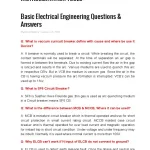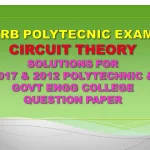Network analysis involves understanding electrical circuits, solving equations, and analyzing systems. This guide contains questions and answers to enhance learning and help in exam preparation. It covers essential concepts, various question types, and detailed solutions for better comprehension of the subject.
Questions and Answers for Network Analysis
Question: What is the purpose of network analysis in electrical circuits?
Answer: Network analysis helps in determining current, voltage, and power across components in an electrical circuit, providing insights for design and troubleshooting.
Question: Define Kirchhoff’s Current Law (KCL).
Answer: Kirchhoff’s Current Law states that the sum of currents entering a node is equal to the sum of currents leaving the node in a circuit.
Question: Define Kirchhoff’s Voltage Law (KVL).
Answer: Kirchhoff’s Voltage Law states that the sum of all voltages around a closed loop in a circuit equals zero.
Question: What is Thevenin’s theorem?
Answer: Thevenin’s theorem states that any linear electrical network can be simplified to a single voltage source and series resistance connected to the load.
Question: What is Norton’s theorem?
Answer: Norton’s theorem states that any linear electrical network can be replaced by an equivalent current source in parallel with a single resistance.
Question: What is the difference between dependent and independent sources?
Answer: Independent sources provide a fixed voltage or current, while dependent sources vary their output based on another circuit parameter.
Question: Explain the concept of superposition theorem.
Answer: The superposition theorem states that in a linear network, the response in any branch is the sum of responses caused by each independent source acting alone.
Question: What is meant by impedance in AC circuits?
Answer: Impedance is the total opposition offered by a circuit to the flow of AC, including resistance and reactance, and is represented as a complex quantity.
Question: Define resonant frequency in an RLC circuit.
Answer: Resonant frequency is the frequency at which the inductive reactance equals the capacitive reactance, resulting in maximum current flow.
Question: What is the purpose of using Laplace transform in network analysis?
Answer: Laplace transform simplifies complex time-domain circuits into the s-domain, making analysis of transient and steady-state behavior easier.
Question: What is meant by a transient response in a circuit?
Answer: Transient response refers to the temporary behavior of a circuit when it switches from one state to another before reaching a steady state.
Question: What is the steady-state response of a circuit?
Answer: Steady-state response is the long-term behavior of a circuit after transient effects have subsided, characterized by constant output.
Question: What is a two-port network?
Answer: A two-port network is an electrical network with two pairs of terminals, used to model systems like amplifiers and filters.
Question: What is the significance of Z-parameters in network analysis?
Answer: Z-parameters (impedance parameters) describe the input and output impedance characteristics of a two-port network.
Question: Define Y-parameters in a two-port network.
Answer: Y-parameters (admittance parameters) describe the relationship between input and output currents and voltages in a two-port network.
Question: What is the maximum power transfer theorem?
Answer: The maximum power transfer theorem states that maximum power is delivered to the load when the load resistance equals the source resistance.
Question: Explain the concept of mutual inductance.
Answer: Mutual inductance occurs when a change in current in one coil induces a voltage in a nearby coil due to magnetic coupling.
Question: What are phasors in AC circuit analysis?
Answer: Phasors represent sinusoidal waveforms as rotating vectors in the complex plane, simplifying AC circuit calculations.
Question: What is a balanced three-phase system?
Answer: A balanced three-phase system has equal voltages and currents in all three phases, separated by 120 degrees in phase angle.
Question: What is an unbalanced three-phase system?
Answer: An unbalanced three-phase system has unequal voltages or currents in the three phases, causing system inefficiencies.
Question: Define power factor in AC circuits.
Answer: Power factor is the ratio of real power to apparent power, indicating the efficiency of power usage in an AC circuit.
Question: What is the difference between series and parallel resonance?
Answer: Series resonance occurs when circuit impedance is minimum, while parallel resonance occurs when impedance is maximum.
Question: What is the purpose of mesh analysis?
Answer: Mesh analysis calculates currents in the loops of a circuit using KVL, simplifying the analysis of planar circuits.
Question: What is nodal analysis?
Answer: Nodal analysis calculates voltages at nodes in a circuit using KCL, simplifying circuit equations.
Question: What is a star-delta transformation?
Answer: Star-delta transformation is a mathematical technique to convert a star network to an equivalent delta network, and vice versa.
Question: Define the term damping in RLC circuits.
Answer: Damping is the reduction in oscillation amplitude in an RLC circuit, determined by the resistance and reactance values.
Question: What is meant by the quality factor in a resonant circuit?
Answer: Quality factor indicates the sharpness of resonance in a circuit and is the ratio of resonant frequency to bandwidth.
Question: What is a time constant in an RC circuit?
Answer: The time constant is the time it takes for the voltage across a capacitor to change by about 63.2% of its initial value.
Question: What is the difference between active and passive components?
Answer: Active components (e.g., transistors) supply energy to a circuit, while passive components (e.g., resistors) do not generate energy.
Question: Define the term bandwidth in the context of filters.
Answer: Bandwidth is the range of frequencies a filter passes or attenuates, measured between the -3dB points of the response curve.
Question: What is the role of a capacitor in AC circuits?
Answer: A capacitor blocks DC and allows AC to pass, storing energy in the form of an electric field.
Question: What is inductive reactance?
Answer: Inductive reactance is the opposition offered by an inductor to the flow of AC, proportional to frequency and inductance.
Question: Define capacitive reactance.
Answer: Capacitive reactance is the opposition offered by a capacitor to the flow of AC, inversely proportional to frequency and capacitance.
Question: What are the conditions for reciprocity in a two-port network?
Answer: Reciprocity exists when the transmission of signals between ports remains the same regardless of direction.
Question: What is the principle of duality in electrical circuits?
Answer: Duality is a concept where two circuits exhibit identical behavior but have interchanged elements, like current and voltage sources.
Question: What is the difference between linear and nonlinear circuits?
Answer: Linear circuits have constant parameters, while nonlinear circuits have parameters that vary with current or voltage.
Question: Explain the concept of an ideal voltage source.
Answer: An ideal voltage source provides a constant voltage regardless of the current drawn by the load.
Question: Explain the concept of an ideal current source.
Answer: An ideal current source provides a constant current regardless of the voltage across its terminals.
Question: What is an operational amplifier?
Answer: An operational amplifier is a high-gain electronic device used to amplify voltage signals and perform mathematical operations.
Question: What is a filter in electrical circuits?
Answer: A filter is a circuit designed to allow certain frequencies to pass while attenuating others, used in signal processing.
Question: What is the significance of Bode plots in network analysis?
Answer: Bode plots graphically represent the frequency response of a system, showing magnitude and phase versus frequency.
Question: Define voltage division rule.
Answer: Voltage division rule calculates the voltage drop across a resistor in a series circuit as a fraction of the total voltage.
Mastering network analysis requires understanding key concepts, solving problems, and practicing questions. This guide provides comprehensive solutions to help you confidently tackle various challenges. Continuous practice and application of these principles ensure better performance in exams and practical scenarios.
Latest Posts
- Step-by-step guide to download and apply for jee mains admit card 202
- Comprehensive 2025 government holidays and recruitment details for job seekers
- JEE Mains Admit Card 2025: Your Step-by-Step Guide to Downloading the Hall Ticket
- Everything You Need to Know About 2025 Government Holidays Recruitment
- Comprehensive Guide to rrb d group recruitment 2025 – Eligibility, Vacancies, and Application
- Detailed guide to nps trust recruitment 2025 vacancies, eligibility and apply process
- Comprehensive guide to hpcl recruitment 2025 notification, vacancies, and application process
- ignou bed admission 2025 complete recruitment guide with eligibility and process
- Comprehensive Guide to Indian Army Agniveer Recruitment 2025 Notification and Jobs
- Everything You Must Know About CBSE Board Exams 2025 Changes & New Rules






